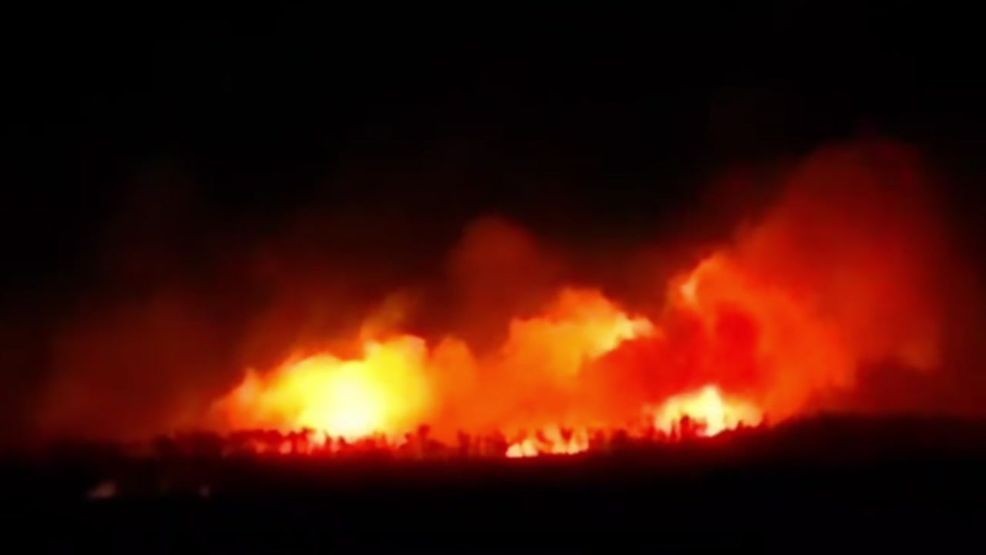(WPDE) — Wildfires need three things to occur: warm and dry conditions, dry fuel (another name for dry vegetation), and an ignition source.
This means the risk for wildfires is highest from about January to April in the Carolinas.
As the Carolinas typically see dryer conditions in this drought season, fires have far more “fuel” for burning should they arise.
In the Southeast’s natural environment, fire is a necessary cycle for ecosystems. A lot of the Southeast was prone to fire even before the European settlement of the United States, meaning it’s been recorded as a frequent occurrence centuries ago.
Yet, while the natural environment of the Southeast needs fire to flourish, wildfires cause dangerous hazards to people and property.
TODAY: SC joins states supporting Trump’s birthright citizenship Executive Order
Dr. Victoria Donovan is an Assistant Professor of Forestry Management at the University of Florida, and she focuses on the beneficial aspects of wildfire on the region’s ecosystems. However, she also warns of the danger to people and property.
“One of the greatest places we see destruction from wildfires is within the wildland-urban interface. So that’s an area where we have development intermingling with natural vegetation and natural fuels. And so that’s generally where we see wildfires having the greatest impact in terms of destroying property and causing a threat to human life and to human health,” Donovan said.
As more people develop land and live closer to the natural environment, the natural balance of wildfire is changing, too.
The sprawling development blurs the line between human development and the natural environment, and the wildfire risk to homes and structures is changing across the Carolinas.
Based on data from the U.S.D.A. Forest Service Wildfire Risk Index, the only sections of the Carolinas with a low risk of wildfires to property exists in parts of the North Carolina Piedmont and northeastern North Carolina.
A medium risk of wildfires threatening property has been noted across much of the Carolinas from the Upstate, Midlands, and parts of the Low Country of South Carolina to areas of western North Carolina and far eastern North Carolina.
A few counties in the Pee Dee and the Border Belt are included in this medium risk, like Marion, Darlington, Chesterfield, Columbus, and Lee Counties.
It has been found that the highest risk of wildfire to property in the Carolinas resides in the Grand Strand, parts of the Pee Dee and Border Belt, far eastern North Carolina, far western North Carolina, and parts of the Lowcountry of South Carolina.
Humans ignite a large percentage of wildfires through actions like improperly discarded cigarette butts, open burning of debris, campfires, heavy equipment, and more. The number of wildfires started by humans surpasses the number of wildfires that ignite due to natural causes exponentially.
However, causing a source of ignition isn’t the only way humans are adding to the risk of wildfires. Human-caused climate change isn’t only causing one type of weather condition in the area to increase or decrease, it’s throwing the natural climate out of rhythm. So, the area is prone to extremes that add to an increased risk of fires.
Dr. Victoria Donovan notes the biggest extremes in climate that add a greater fire danger to an area is the fluctuation between very wet times and very dry times.
“When we have oscillations from wet to dry, that can increase fire risk because we see wet conditions creating a flush of vegetation and then all that vegetation dries out, so we have that excess fuel”, said Dr. Donovan.
To lessen the wildfire risk, prescribed burning is utilized not only as a method to manage the land and ecosystems but also to reduce the amount of dry fuels available. But due to the changing climate, the number of days prescribed fire can be implemented are decreasing.
Dr. Donovan explains that, “When we have these kinds of changing climate conditions where things are getting warmer and drier, you know, it can also make optimal burn days for applying prescribed fire a lot less frequent. So we lose the ability to apply fire, prescribed fires.”
So while wildfires are ecologically important for the natural environment to prosper, they are becoming a larger risk to people and to property due to human-caused climate change, sprawling development, and poor land management.
